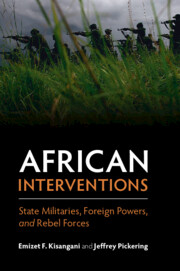Book contents
- African Interventions
- African Interventions
- Copyright page
- Dedication
- Contents
- Figures
- Tables
- Acknowledgments
- Abbreviations
- 1 Context and Issues of International Military Intervention
- 2 Non-colonial Military Interventions in Africa
- 3 Military Intervention by Former Colonial Powers in Africa
- 4 Intra-African Hostile Military Intervention
- 5 Intra-African Supportive Military Intervention
- 6 African Intervention into Failed States
- Conclusion
- Appendices
- Notes
- References
- Index
2 - Non-colonial Military Interventions in Africa
Published online by Cambridge University Press: 29 October 2021
- African Interventions
- African Interventions
- Copyright page
- Dedication
- Contents
- Figures
- Tables
- Acknowledgments
- Abbreviations
- 1 Context and Issues of International Military Intervention
- 2 Non-colonial Military Interventions in Africa
- 3 Military Intervention by Former Colonial Powers in Africa
- 4 Intra-African Hostile Military Intervention
- 5 Intra-African Supportive Military Intervention
- 6 African Intervention into Failed States
- Conclusion
- Appendices
- Notes
- References
- Index
Summary
Chapter 2 presents a historical outline of military interventions into Africa by non-colonial actors and uses Qualitative Comparative Analysis to investigate the causes of such interventions. It begins with a historical summary of the sometimes large-scale military interventions taken during the Cold War by the Soviet Union, Cuba, and the United States (US). It then looks at US military intervention on the continent after the end of the Cold War, noting a change in motives following the 9/11 terror attacks in the US. The chapter documents the more covert, but lasting, form that US military intervention took following 9/11 (a phenomenon some have termed “liquid” warfare) and the increasing US use of drone attacks against Islamic terror groups. Following this review of superpower and superpower proxy activity, the chapter outlines the interventionary record of other non-colonial external actors. It examines actions taken by Israel within Africa, the Chinese naval presence off of the Somali coast since 2008, and a handful of small European evacuation and rescue missions. Results from qualitative comparative analysis suggest that combinations of conditions like national role conceptions, rivalry, capabilities and at times mass unrest within the intervening state help to explain many of these external interventions.
Keywords
- Type
- Chapter
- Information
- African InterventionsState Militaries, Foreign Powers, and Rebel Forces, pp. 49 - 84Publisher: Cambridge University PressPrint publication year: 2021



